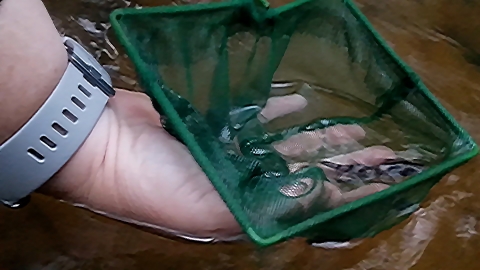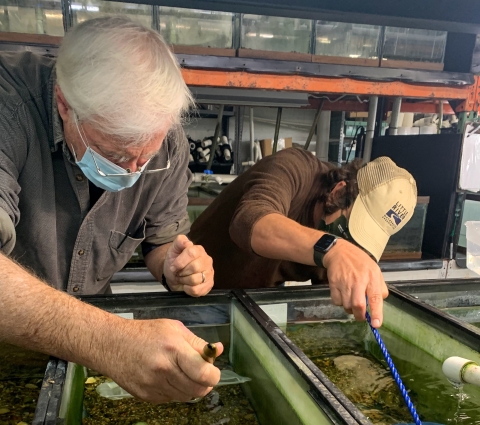Meet the newest neighbors at the Sandy Creek and Lower Fishing Creek Gamelands in Franklin County, North Carolina: some little fish with a big future for waterways in eastern North Carolina.
About 260 juvenile Carolina madtoms, roughly 3 months old, and 2 inches long were raised at a hatchery in Knoxville, Tennessee. As the first cohort of Carolina madtoms produced in captivity, they are direct descendants of fish that were collected from the same Tar River watershed in 2018.
On November 2nd, 2021, biologists released them in waterways just northeast of Raleigh -- roughly 400 miles and over eight hours’ drive from the tanks where they grew large enough to return to their native waters. A lot of hope is riding on these fish, declared a federally endangered species in 2021. Their mission is to give their species a much-needed boost in numbers in the wild, a chance to survive into the future. This fish release, called a population augmentation, is the culmination of 4 years of planning among the US Fish and Wildlife Service, the NC Wildlife Resources Commission and Conservation Fisheries Inc (CFI).
Based in Knoxville, CFI is a non-profit organization dedicated to enhancing the Southeast’s aquatic biodiversity.
As of today, it has received $95,000 in funding from the National Fish and Wildlife Foundation to collect juveniles and eggs from the wild and to figure out how to propagate them in captivity. Some were collected from “madtom motels,” nifty structures designed by North Carolina State University and the U.S. Geological Survey, to provide cover for nests in the wild.
For years, Conservation Fisheries and the North Carolina Wildlife Resources Commission have been working to collect broodstock broodstock
The reproductively mature adults in a population that breed (or spawn) and produce more individuals (offspring or progeny).
Learn more about broodstock and perfect protocols: sweating the small stuff, working out the details about water pH balance, temperatures, and other matters that make or break the success of keeping fish alive and reproducing in tanks.
That research has had positive results in the natural world, too. Scientists, knowing what allows madtoms to thrive, chose fish-release locations with good water quality and a healthy community of mussels and fish. The habitats also have lots of trees shading the streams, and plenty of cover, like rocks and boulders, for the madtoms to hide. Also, flathead catfish, an invasive predator, have not been found in these areas.
Once the state approved the release, CFI tagged the madtoms with a color-coded polymer implanted under their skin. The color of the tag -- in this case, orange -- identified the fish as members of a single class. CFI carefully packed and drove the fish to the Marion Conservation Aquaculture Center in the North Carolina mountains. There, the nonprofit handed off the fish to the North Carolina Wildlife Resources Commission. From there, the young fish headed east.
The commission’s Eastern Region Aquatic Wildlife Diversity team accepted the fish.
Upon arrival at Franklin County release site, the team collected a small tissue sample from each fish. “We are getting fin clips so we can look at the long-term genetics of the fish we are stocking,” said team coordinator Michael Fisk. “We have fin clips from the brood stock and from all their offspring. We’ll be able to recapture those throughout the years and look at stocking success.”
The work is not finished. The plan is to continue producing more Carolina madtoms in captivity and periodically release more into the wild to recover this endangered fish. The day someone recaptures a captively reared Carolina madtom will be confirmation that the Carolina madtom is surviving and thriving on its own in the wild!






